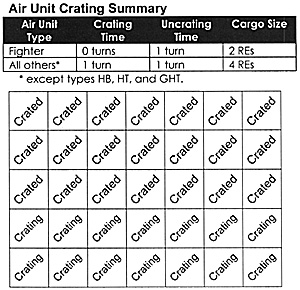 Here's an unofficial optional rule you can use in Second Front. A caveat is that the crating rule is not fully researched, particularly in the area of crating/uncrating times. However, conservative estimates for crating/uncrating times were used, so it is unlikely the Allied player gains any significant historical capability using this rule.
Here's an unofficial optional rule you can use in Second Front. A caveat is that the crating rule is not fully researched, particularly in the area of crating/uncrating times. However, conservative estimates for crating/uncrating times were used, so it is unlikely the Allied player gains any significant historical capability using this rule.
The Allied player may crate certain air units and move them using naval transport. All air units except types HB, HT, and GHT may be crated. To be crated, the air unit must be at an airbase which is in a hex containing a port, and the crating time cost must be accounted for (see the Air Unit Crating Summary). For example, a fighter being crated in the Allied initial phase of Sep I 43 is immediately crated (0 turns crating time), while a type B (1 turn crating time) being crated at the same time would be crated in the Allied initial phase of Sep II 43. (All crating and uncrating times are given in game turns.) Use any convenient marker to denote a crated air unit; a crated air unit may not fly any air mission.
A crated air unit may be transported by naval transport. Its cargo size is given on the Air Unit Crating Summary. It may be disembarked at any port that contains a friendly-owned airbase. The air unit is not uncrated upon disembarkation. Instead, the Allied player may uncrate during Allied initial phases, and the uncrating time cost must be accounted for. For example, a fighter being uncrated in the Allied initial phase of Sep II 43 would finish uncrating in the Allied initial phase of Oct I 43. Once an air unit is finished uncrating, it may become operational that same phase if airbase capacity allows.
More Inside Europa
-
Crating Air Units
Garrisons
Second Front Player Sequence
British Cadres
Second Front Off-Map Movement
Back to Europa Number 59-60 Table of Contents
Back to Europa List of Issues
Back to MagWeb Master Magazine List
© Copyright 1997 by GR/D
This article appears in MagWeb (Magazine Web) on the Internet World Wide Web. Other military history articles and gaming articles are available at http://www.magweb.com